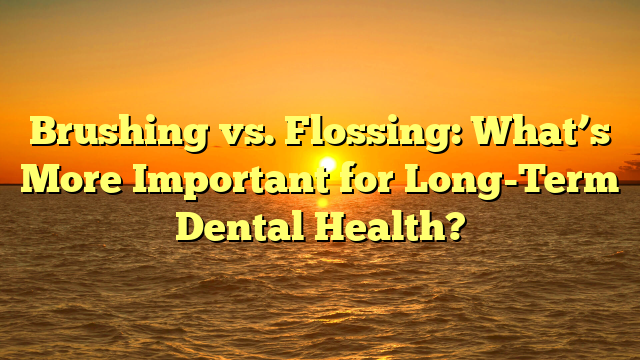Understanding the Basics of Oral Hygiene
Why Oral Hygiene Matters for Overall Health
Oral hygiene is not just about having a bright smile or fresh breath—it’s a window into your overall health. Poor oral health has been linked to a range of systemic diseases, including diabetes, heart disease, and even respiratory infections. Taking care of your teeth and gums can go a long way toward protecting your general well-being.
The Role of Daily Oral Care in Preventing Disease
Daily habits like brushing and flossing are your first line of defense against plaque buildup, gum inflammation, and cavities. These routines help control the bacteria in your mouth, preventing it from turning harmful and spreading to other parts of the body through the bloodstream.
The Science Behind Brushing
How Brushing Removes Plaque and Bacteria
Brushing works by physically scrubbing away food particles, bacteria, and plaque—the sticky film that builds up on your teeth. When plaque isn’t removed, it can harden into tartar, which can only be cleaned by a dentist. Brushing twice a day helps minimize the buildup of plaque, protecting the enamel and reducing the risk of cavities and gum disease.
Types of Toothbrushes and Their Effectiveness
From manual to electric, toothbrushes come in many forms. Electric brushes often offer better results due to their consistent and thorough movements, while soft bristles are recommended to protect your gums. The key is not just the type, but how and how often you use it.
Best Brushing Techniques for Maximum Impact
Use a pea-sized amount of fluoride toothpaste and angle the brush at 45 degrees to your gums. Use gentle, circular motions for at least two minutes, reaching all surfaces of your teeth—inside, outside, and chewing surfaces. Don’t forget to brush your tongue to remove bacteria and freshen your breath.
The Science Behind Flossing
What Happens Between the Teeth
Flossing targets the 30-40% of tooth surface that brushing misses—those tight spaces between teeth where food particles and plaque can accumulate. Neglecting these areas can lead to gum inflammation, decay, and even tooth loss over time.
Different Floss Types and Their Uses
There are many types of floss: waxed, unwaxed, dental tape, and even flavored varieties. People with braces or tight contacts may benefit from floss threaders or picks. Water flossers are a great alternative for those who find traditional floss challenging.
Proper Flossing Techniques to Follow
Wrap about 18 inches of floss around your fingers and slide it gently between your teeth. Curve it into a “C” shape against each tooth and move it up and down. Avoid snapping it into the gums, which can cause damage.
Brushing vs Flossing Dental Health Debate
What Dentists Say About Brushing vs. Flossing
Most dentists agree: brushing and flossing are not interchangeable but complementary. Brushing tackles surface cleaning, while flossing reaches the in-between spots. The American Dental Association (ADA) recommends doing both daily for optimal oral health.
Key Areas Each Method Targets
Brushing is effective for cleaning the front, back, and chewing surfaces. Flossing zeroes in on the spaces between the teeth and under the gum line, places your brush can’t reach.
Can One Replace the Other?
No. Relying solely on brushing leaves a significant part of your teeth uncleaned. Similarly, only flossing would miss the outer and chewing surfaces. You need both to fully protect your teeth and gums.
Long-Term Dental Health: What Really Matters?
Preventing Gum Disease and Tooth Decay
Regular brushing and flossing work together to prevent the two biggest threats to dental health: cavities and gum disease. Left untreated, these conditions can lead to tooth loss and more serious health issues.
The Importance of Consistency Over Technique
While technique is important, consistency is key. Even if your brushing or flossing isn’t perfect, doing it regularly provides tremendous benefit. Think of it as a marathon, not a sprint.
Common Mistakes in Brushing and Flossing
Overbrushing and Its Side Effects
Brushing too hard or too often can erode enamel and damage your gums. Use gentle pressure and let the toothbrush do the work.
Flossing Too Aggressively or Too Little
Flossing too forcefully can cut or bruise your gums, while inconsistent flossing leads to buildup and irritation. Balance is essential.
Role of Diet and Lifestyle in Oral Health
Foods That Harm or Help Your Teeth
Sugary snacks and acidic drinks erode enamel and feed harmful bacteria. Meanwhile, foods rich in calcium, fiber, and vitamin D strengthen your teeth and gums.
Smoking, Alcohol, and Their Impact on Oral Hygiene
Tobacco and excessive alcohol dry out your mouth and increase the risk of gum disease and oral cancer. Reducing or eliminating these habits improves your dental health significantly.
